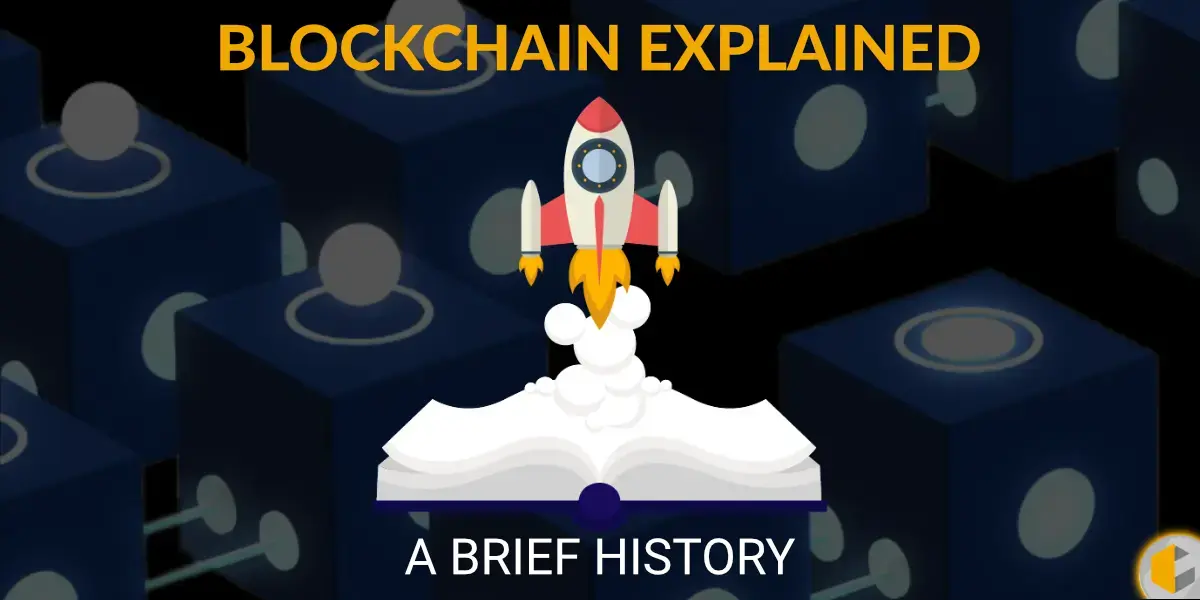
Since its mainstream debut, blockchain has been regarded as one of the most potentially disruptive technologies for a number of industries today.
Despite its relatively short history, the rise of blockchain technology is often compared to that of the internet, and for good reason.
The early days of the internet were confusing as well. Communication worked fine as it was, and people wondered why they needed this new — and expensive — method of sharing information. There was skepticism at first, but as the internet’s utility and accessibility improved, the public’s perception of it changed dramatically, and it soon became widely adopted.
Regardless of how perplexing blockchain technology may appear at first glance, it holds the same potential for driving economic innovation as the internet did for social interaction and information exchange.
Unfortunately, it can be challenging to find detailed blockchain explanations in plain English. So here at CryptoCoin, we’ve created a series of articles designed to present acomprehensive, step-by-step blockchain guide for beginners, investors, or anyone interested in having blockchain explained with as little complicated jargon as possible.
In the coming articles, we will lay out everything from what blockchain is and why it matters, to how blockchain works. We will also examine the current use of blockchain technology within Australia and around the world, as well as how blockchain applications will — and have already begun to — move beyond finance, due to the real-life blockchain use cases emerging in a wide range of industries today.
The purpose of this series is to deconstruct blockchain so that you can make informed investment decisions and hold your own in conversations surrounding this disruptive new technology. Consider this an introductory course in blockchain technology — a sort of “blockchain 101.”
History of Blockchain — Timeline
1982
David Chaum publishes his thesis “Computer Systems Established, Maintained, and Trusted by Mutually Suspicious Groups,” outlining the basic elements of the blockchain model later adopted by Satoshi Nakamoto in 2008.
1991
The concept of a cryptographically secured chain of data is introduced by Stuart Haber and W. Scott Stornetta, who go on to design digital certificates that ensure document timestamps can not be altered.
1998
Computer scientist and scholar, Nick Szabo, develops a system for decentralized digital currency “bit gold,” — viewed as a clear forerunner to bitcoin.
2008
A developer (or group of developers) working under the alias Satoshi Nakamoto publishes a white paper modeling the first blockchain in a cryptocurrency known as bitcoin.
2009
Bitcoin is made available to the open source community, thereby releasing the first blockchain to the public as a decentralized ledger for cryptocurrency transactions.
2010
Satoshi Nakamoto outlines a more adaptable framework, dubbed “blockchain 2.0” by the community, to handle applications beyond cryptocurrency.
2014
As blockchain technology becomes disentangled from cryptocurrency, a wave of investment and research into its potential applications across a broader range of industries starts to emerge.
2015
The Ethereum blockchain system goes live, becoming the world’s second public blockchain. Ethereum develops a “smart contracts” protocol, allowing code within the blockchain to automatically manage and represent real-world assets such as stocks, bonds, and real estate — a key feature of blockchain 2.0.
Early Development of Blockchain Technology
These days, we’re able to identify key events in the evolution of the internet that effectively split the process into stages. Understanding each stage of development is critical to comprehending why the internet is what it is today. Similarly, it’s possible to look back on blockchain’s evolution and divide it into stages defined by significant developments and milestones.
As blockchain technology is still in its infancy, there will almost certainly be more advancements in the future. Nonetheless, the history of blockchain as we know it can be divided into fairly distinct periods of conceptualization, development, and distribution.
From David Chaum in 1982, to Stuart Haber and W. Scott Stornetta’s work in 1991, the ideas that would eventually culminate in the invention of blockchain had already been circulating for quite some time — spanning nearly 40 years of research.
Hailed as the forefather of cryptocurrency and the earliest precursor to Bitcoin, David Chaum’s 1982 thesis, “Computer Systems Established, Maintained, and Trusted by Mutually Suspicious Groups,” outlined a framework complete with executable code containing all but one function of the blockchain model that would be later described in the Bitcoin Whitepaper.
In 1991, Stuart Haber and W. Scott Stornetta expanded on this by developing a solution based on digital certificates, which ensured that the timestamps on secured documents could not be altered, effectively introducing the earliest concept of a cryptographically protected chain for blocks of data.
While Haber and Stornetta, in collaboration with Dave Bayer, updated the system in 1992 to capture multiple document certificates into a single root block of data, computer scientist and scholar Nick Szabo had begun working on a system for a decentralized digital currency he called “bit gold”.
Bit gold is often referred to as the direct prelude to bitcoin as it outlined many of the elements found in Satoshi Nakamoto’s bitcoin model. These elements included the use of various cryptographic structures and computer mining to create a decentralized network, as well as the storage of time-stamped blocks generated through a proof-of-work algorithm based on computational effort.
Unsurprisingly, there has been speculation that Nick Szabo is Satoshi Nakamoto, the anonymous developer of bitcoin. Although the bit gold and bitcoin frameworks are incredibly similar, Szabo has denied this claim (along with many others who have been rumoured to be bitcoin’s anonymous creator).
Szabo also proposed the initial concept of smart contracts — pre-programmed transaction protocols that automatically document and execute actions in accordance with the terms of a contract. When a condition specified in the smart contract is met, predefined aspects of the contract are then automatically distributed or performed.
Satoshi Nakamoto & Blockchain 2.0
“Bit gold” as a concept first surfaced publicly in 1998, but the project was never finalised. Blockchain technology as we know it wouldn’t come to fruition until 2008, when a person (or possibly a group of people) known as Satoshi Nakamoto modeled the first blockchain. Nakamoto improved the designs outlined in previous years even further by introducing a proof-of-work system similar to Adam Back’s Hashcash algorithm in 1997. Nakamoto used this algorithm to timestamp blocks without requiring them to be signed by a third-party.
Satoshi Nakamoto also introduced a “difficulty” protocol to the blockchain to help maintain a consistent average amount of blocks added onto the chain each hour, even as the network fluctuates.
This adaptation was key, and it is still an integral feature of cryptocurrency design and development, serving as the foundational structure for all transactions on many cryptocurrency networks.
But Satoshi Nakamoto never envisioned blockchain technology as being restricted to cryptocurrency.
“The nature of Bitcoin is such that once version 0.1 was released, the core design was set in stone for the rest of its lifetime. Because of that, I wanted to design it to support every possible transaction type I could think of,” —Nakamoto writes of the updated blockchain framework in a public forum post from 2010.
“…Escrow transactions, bonded contracts, third party arbitration, multi-party signature[s], etc. If Bitcoin catches on in a big way, these are things we’ll want to explore in the future, but they all had to be designed at the beginning to make sure they would be possible later.”
Though Bitcoin remained unchanged, those in the community unanimously dubbed this concept “blockchain 2.0.” Five years later, in mid 2015, Ethereum made its debut, bringing to life key features of blockchain 2.0, including “smart contracts,” — digital contracts stored on the Ethereum blockchain that can define terms between parties and enforce them by automatically running predefined code when certain criteria are met.
Expanding the applications of blockchain technology in this way differentiates cryptocurrency as a financial asset from blockchain as a programmable system, paving the way for blockchain technology to be used in industries and applications other than finance.
Editor-in Chief
Related Posts






Subscribe to our newsletter!
Information



